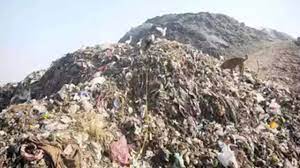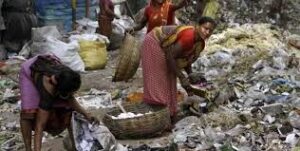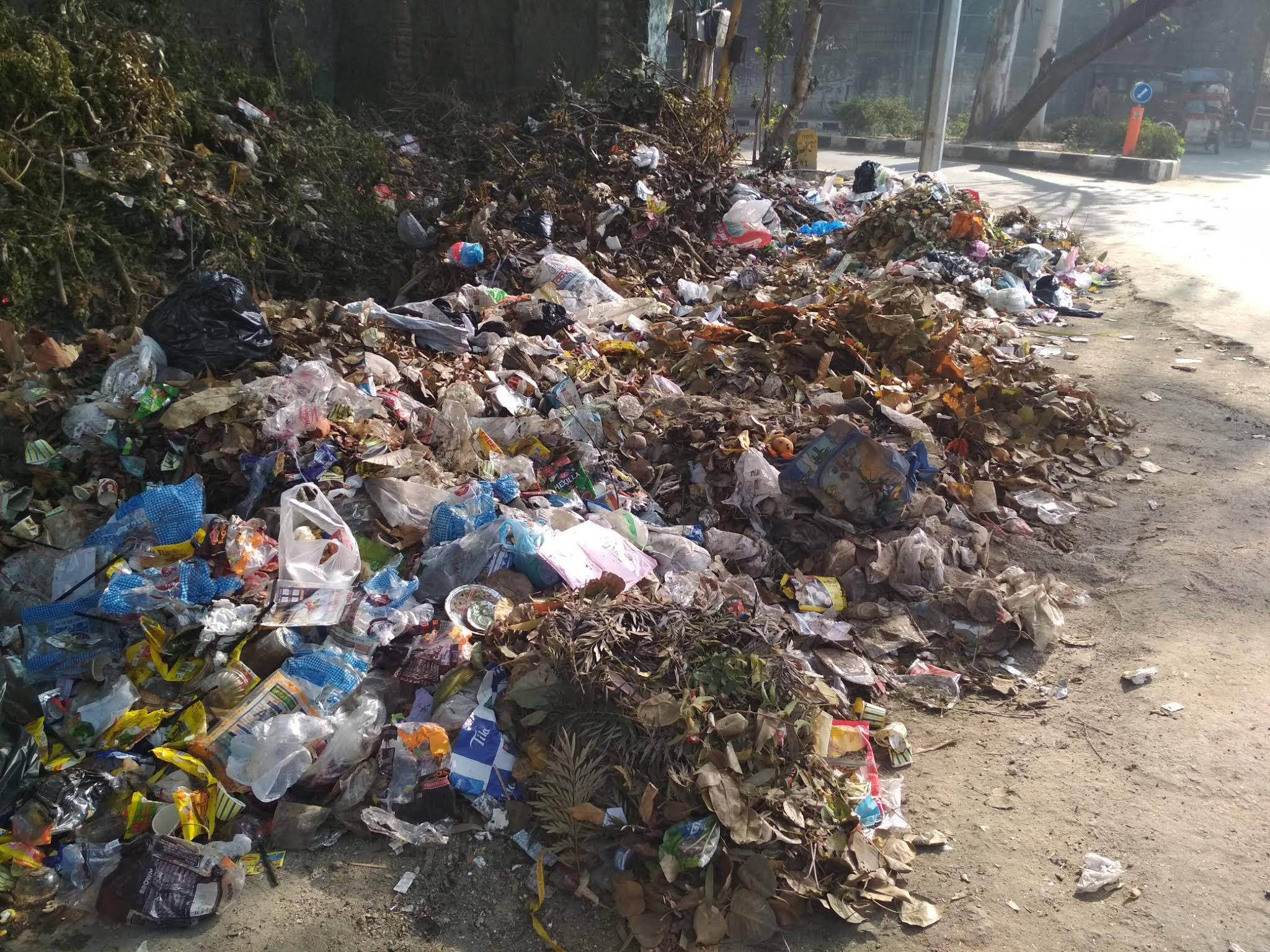South India faces significant challenges in managing municipal solid waste, with issues ranging from inadequate collection and processing to improper disposal and a lack of public awareness. The region struggles with high waste generation rates, especially in urban areas, and a large proportion of waste ends up in landfills or is openly dumped, posing environmental and health risks.

Overflowing Cities, Sinking Futures
Walk past the towering Kodungaiyur landfill in Chennai or the smoke-shrouded skies of Kochi’s Brahmapuram, and it’s clear: South India is buckling under the weight of its own waste.
The numbers are staggering. Every day, the five southern states—Tamil Nadu, Karnataka, Kerala, Andhra Pradesh, and Telangana—generate over 45,000 tonnes of municipal solid waste. That’s nearly one-third of India’s total. With rapid urbanisation and rising consumption, this figure is expected to double by 2035.
But it’s not just about volume—it’s about failure. Poor segregation, outdated infrastructure, neglected waste workers, and public apathy have turned trash into a ticking time bomb.
A Snapshot of South India’s Waste Landscape
Here’s what daily waste generation looks like in some major cities: Hyderabad: 6,500 tonnes, Chennai: 6,300 tonnes, Bangalore: 4,500 tonnes, Coimbatore: 1,100 tonnes and Kochi: 700 tonnes.
Yet, less than 30% of this waste is processed scientifically. Most of it ends up in open dumps, burning landfills, or clogged water bodies. In places like Jawahar Nagar (Hyderabad) and Kodungaiyur (Chennai), leachate and methane leak into nearby neighbourhoods, affecting both health and livelihoods. Villages on city outskirts are turning into dumping grounds—without consent, compensation, or accountability.
SECTOR-WISE WASTE GENERATION IN INDIA
When we break down India’s waste, two things stand out. First, more than 50% of municipal solid waste is organic, made up of food scraps, market waste, and garden clippings. Ideally, this could be composted or turned into biogas. But with over 70% of waste still unsegregated, most of it ends up in dumpsites, mixed with inerts (33%), plastics (6%), and other dry waste. Recyclables—like paper (7%), metals (2%), and glass (2%)—are lost in the mix, reducing both resource recovery and income for waste pickers. Second, when we look at the sectoral sources of this waste, households and public spaces account for about 45%, but industries (25%), agriculture (10%), biomedical (10%), and e-waste (10%) form the rest. These non-household streams often include hazardous materials, but are rarely tracked or treated properly. Together, these two charts reveal a deeper problem: waste in India isn’t just a disposal issue—it’s a mismanagement crisis. Solving it means targeting both what we throw and who throws it.
WHY THE SYSTEM IS COLLAPSING ?
1. Lack of Segregation
Despite laws mandating source segregation, over 70% of waste remains mixed. This makes recycling or composting virtually impossible.
2.Outdated Infrastructure
Dry waste collection centres are sparse. Composting facilities and waste-to-energy plants are either underused or dysfunctional due to poor planning.
3.Invisible Waste Workers
South India’s recycling backbone—its 60,000 to 80,000 informal waste workers—remain invisible in policy. Many, often women from marginalized communities, lack basic protections like health insurance or safety gear.

4. Plastic Overload
Single-use plastics still dominate markets. Despite bans in Tamil Nadu and Kerala, enforcement is lax, and illegal trade thrives.
5. Failed Waste-to-Energy Projects
Several WTE plants shut down due to toxic emissions and community resistance. The 2023 Brahmapuram fire in Kochi was a stark reminder—poisonous smoke from burning plastic engulfed the city for days.
A CRISIS BEYOND TRASH
This isn’t just a sanitation issue—it’s an environmental and humanitarian crisis. Toxic air from landfill fires, Poisoned rivers like the Adyar (Chennai) and Musinagar (Hyderabad), Health hazards for waste pickers and informal settlers, Destroyed farmlands and contaminated groundwater near dump sites. But in this landscape of neglect, Bangalore is carving a different path.
BANGALORE: FROM GARBAGE CITY TO GREEN HOPE
Once infamous for its 2012 garbage crisis, Bangalore is slowly transforming into a model of urban resilience. Generating over 4,500 tonnes of waste daily, the city is investing in solutions rooted in community action, decentralised systems, and smart technology.
Here’s how it’s making a difference:
1. Segregation at Source
Bangalore mandates household-level segregation into wet, dry, and hazardous waste. In areas like HSR Layout and JP Nagar:
QR-coded bins and tracking apps are in use.
Kannada-language campaigns build awareness.
Fines and incentives promote compliance.
In well-segregated wards, up to 70% of waste is diverted from landfills.
2. Composting & Biomethanation
Since 60% of Bangalore’s waste is organic, the focus is on converting it into resource. Kasa Rasa, a citizen-run composting unit in Koramangala, is a local success. Biogas plants at Domlur and KR Market turn food waste into cooking fuel. BBMP mandates bulk generators (like tech parks) to manage their own waste on-site.
3. Dignity for Waste Workers
Groups like Hasiru Dala and Saahas Zero Waste have transformed waste work in Bangalore. Workers now have ID cards, safety gear, and access to healthcare. Many are part of formal collection systems, with regular pay and recognition. Still, more needs to be done—legal protections and co-operative ownership are the next steps.
4. Smart Technology for Smarter Cities
Tech is helping streamline waste operations:
- GPS-tracked collection trucks.
- IoT-enabled bins.
- Citizen complaint redressal via the Swachhata App.
- Real-time ward-level performance dashboards.
Bangalore is exploring AI-based sorting and open data platforms to reduce leakages and corruption.
5.Circular Economy & Safe Waste-to-Energy
While past WTE models failed, new approaches are emerging:
- RDF (Refuse-Derived Fuel) plants at Kannahalli and Doddabidarakallu process 750 tonnes/day.
- Startups like Swachha Eco Solutions upcycle plastic into tiles and furniture.
- But the key lies in Extended Producer Responsibility (EPR)—holding brands accountable for the waste they create.
6.Rebuilding Infrastructure
Instead of centralised landfills, Bangalore is building decentralised hubs:
- Composting and biogas units at ward level.
- More Dry Waste Collection Centres (DWCCs).
- Engineered landfills with leachate control and gas capture.
It’s a slow process—but the blueprint is changing.
7. Pay-As-You-Throw
Pilots in select wards are testing user fees and Pay-As-You-Throw (PAYT) models. Bulk generators like malls and hotels are being charged. Households may follow, depending on volume and segregation. This economic shift encourages responsibility—and disincentivises waste.
8.Civic Action & Behavioural Change
At the heart of this transformation is public participation. Campaigns like 2Bin1Bag, Beautiful Bengaluru, and Swachhagraha are driving awareness through:
- Street art, clean-up drives, and community composting festivals.
- School education programs and civic innovation contests.
- The goal: change the culture, not just the system.
SOLUTIONS TO WASTE CRISIS IN SOUTH INDIA
- Policy & Infrastructure
- Enforce waste segregation at source (wet, dry, hazardous).
- Build decentralized waste units (composting, recycling) at ward level.
- Support waste pickers with ID cards, safety gear, and training.
- Implement strict monitoring of municipalities and penalize non-compliance.
- Promote zero-waste models in communities and apartments.
- Use of Technology (Refer to Figure 8)
- Use AI and image-based models to detect illegal garbage dumps.
- Deploy CCTV or drone images for real-time dump monitoring.
- The model (Figure 8) includes: Image collection and cleaning, CNN model training, Dump detection and survey validation. Helps in quick identification and action on dump sites.
- Smart Systems
- Install smart bins with sensors to alert when full.
- Use real-time dashboards to monitor waste movement and complaints.
- Develop mobile apps for public reporting of illegal dumping.
- Public Awareness
- Run local language campaigns on segregation and cleanliness.
- Involve schools and RWAs in clean-up drives and waste management.
- Build Smart SWM System with IoT & ICT (Based on Image 2 – Figures 6 & 7)
- Connect smart bins to sensors that send alerts when full.
- Use GPS tracking for garbage trucks to optimize routes and reduce fuel/time waste.
- Set up a central control system to monitor.
- Bin levels, truck movement, waste volume.
- Weather & pollution data for planning.
- Mobile apps for citizens to:
- Report dumps.
- Track collection schedules.
- Rate cleanliness and services.
- Engage Citizens and Local Bodies
- Encourage source-level segregation (wet/dry/hazardous).
- Run awareness campaigns in local languages using schools, RWAs, SHGs.
- Provide incentives for zero-waste homes and bulk generators.
- Appoint local waste champions in each ward for monitoring.
- Strengthen Policy & Infrastructure.
- Mandate smart SWM systems in Smart Cities Mission and AMRUT towns.
- Fund decentralized processing units for composting, biogas, recycling.
- Train municipal staff in data-driven waste management.
- Use real-time dashboards to track performance of contractors and services.
Impact of Smart SWM
Faster dump detection = Cleaner public spaces.
Route optimization = Lower emissions and costs.
Digital records = Accountable governance.
Citizen engagement = Long-term behavioral change.
SOLID WASTE MANAGEMENT IN TAMIL NADU AND SMART SYSTEMS IN INDIA
Tamil Nadu generates ~14,600 tons of solid waste daily; 95% is collected, mostly through door-to-door services.
- Waste goes through collection → transport → processing → disposal (landfills, recycling, composting, waste-to-energy).
- Major cities like Chennai and Coimbatore produce the most waste; organic waste is the largest component.
- 11 Smart Cities in TN (e.g., Tirunelveli, Salem) show high waste collection and segregation efficiency (up to 100%).
Smart Waste Management (ICT & IoT)
- Uses smart bins, GPS, sensors, and apps to track and optimize waste collection.
- Improves efficiency, reduces costs, and supports data-driven decisions.
AI-Based Garbage Detection
- Uses image processing and CNN models to detect garbage zones.
- Helps authorities identify and act on illegal dump sites in real time.
CONCLUSION
Bangalore stands today not just as India’s IT capital, but as a symbol of a larger urban paradox—prosperity sitting atop piles of unmanaged waste. The city’s expanding footprint, mismatched infrastructure, and years of neglect have turned waste management into a full-blown civic emergency.
The data is clear: unauthorized dumping sites are growing, informal practices persist, and the gap between waste generation and sustainable disposal is only widening. While citizens, NGOs, and parts of the government have begun to act, the system remains fragmented—caught between policy intent and practical enforcement.
The future of Bangalore depends on whether it can rethink waste not as a problem to be pushed outward, but as a resource to be managed inward—with accountability, equity, and science at its core.
As Jane Goodall once said:
“You cannot get through a single day without having an impact on the world around you. What you do makes a difference, and you have to decide what kind of difference you want to make.”
“Waste is not what we throw away—it’s what we fail to value.”
References
- Rajput, R., Prasad, G., & Chopra, A. K. (2009). Scenario of solid waste management in present Indian context. Caspian Journal of Environmental Sciences, 7(1), 45–53.
- Central Pollution Control Board (CPCB). (2004–2005). Status Report on Municipal Solid Waste Management in India. Ministry of Environment and Forests, Government of India.
- Sharholy, M., Ahmad, K., Mahmood, G., & Trivedi, R. C. (2008). Municipal solid waste management in Indian cities – A review. Waste Management, 28(2), 459–467.
- Pappu, A., Saxena, M., & Asolekar, S. R. (2007). Solid wastes generation in India and their recycling potential in building materials. Building and Environment, 42(6), 2311–2320.
- Srivastava, V., Ismail, S. A., Singh, P., & Singh, R. P. (2015). Urban solid waste management in the developing world with emphasis on India: Challenges and opportunities. Reviews in Environmental Science and Bio/Technology, 14, 317–337.
- Sharma, S., & Shah, K. W. (2005). Generation and disposal of solid waste in Hoshangabad. Indian Journal of Environmental Protection, 25(11), 1035–1039.
- Ministry of Environment, Forest and Climate Change (MoEFCC). (2016). Solid Waste Management Rules, 2016. Government of India.
- CPCB & NEERI. (Various years). Waste characterization and management studies in Indian cities. Retrieved from: https://cpcb.nic.in.
- Hasiru Dala:https://hasirudala.in.
- Saahas Zero Waste: https://saahaszerowaste.com.
- Swachha Eco Solutions: https://swachha.in.
- Solid Waste Management Rules, 2016.
- BBMP Waste Management Portal.
- Swachhata App (Grievance Redressal).

